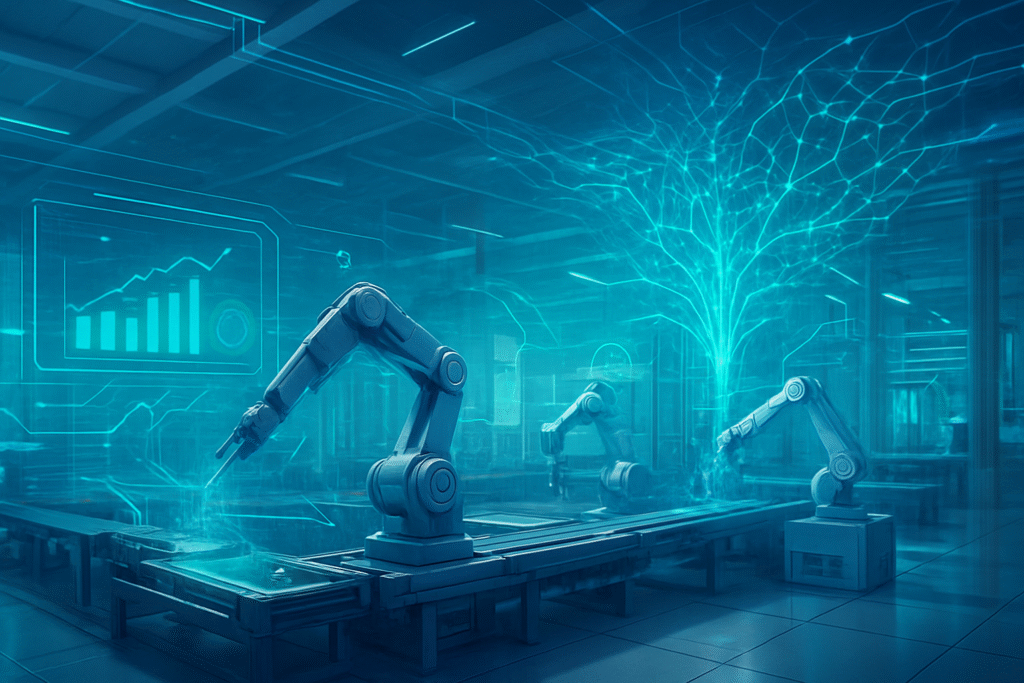
Tokyo, Japan – October 29, 2025 – Hitachi (TYO: 6501) has witnessed a significant surge in its stock value, with shares jumping 10.3% in Tokyo following a series of ambitious announcements detailing a profound expansion into the artificial intelligence sector. This market enthusiasm reflects strong investor confidence in Hitachi's multi-faceted AI strategy, which includes pivotal partnerships with leading AI firms, substantial infrastructure investments, and a sharpened focus on "Physical AI" solutions. The conglomerate's proactive approach to embedding cutting-edge AI across its diverse business segments signals a strategic pivot designed to leverage AI for operational transformation and new growth avenues.
The immediate significance of these developments is multifold. Hitachi is not merely adopting AI but positioning itself as a critical enabler of the global AI revolution. By committing to supply energy-efficient infrastructure for data centers, collaborating on advanced AI agents with tech giants, and acquiring specialized AI firms, Hitachi is building a robust ecosystem that spans from foundational power delivery to sophisticated AI application. This strategic foresight addresses key bottlenecks in AI growth—namely, energy and specialized talent—while simultaneously enhancing its core industrial and infrastructure offerings with intelligent capabilities.
Technical Deep Dive: Hitachi's AI Architecture and Strategic Innovations
Hitachi's (TYO: 6501) AI expansion is characterized by a sophisticated, layered approach that integrates generative AI, agentic AI, and "Physical AI" within its proprietary Lumada platform. A cornerstone of this strategy is the recently announced expanded strategic alliance with Google Cloud (NASDAQ: GOOGL), which will see Hitachi leverage Gemini Enterprise to develop advanced AI agents. These agents are specifically designed to enhance operational transformation for frontline workers across critical industrial and infrastructure sectors such as energy, railways, and manufacturing. This collaboration is a key step towards realizing Hitachi's Lumada 3.0 vision, which aims to combine Hitachi's deep domain knowledge with AI for practical, real-world applications.
Further solidifying its technical foundation, Hitachi signed a significant Memorandum of Understanding (MoU) with OpenAI (Private) on October 2, 2025. Under this agreement, Hitachi will provide OpenAI's data centers with essential energy-efficient electric power transmission and distribution equipment, alongside advanced water cooling and air conditioning systems. In return, OpenAI will supply its large language model (LLM) technology, which Hitachi will integrate into its digital services portfolio. This symbiotic relationship ensures Hitachi plays a vital role in the physical infrastructure supporting AI, while also gaining direct access to state-of-the-art LLM capabilities for its Lumada solutions.
The establishment of a global Hitachi AI Factory, built on NVIDIA's (NASDAQ: NVDA) AI Factory reference architecture, further underscores Hitachi's commitment to robust AI development. This centralized infrastructure, powered by NVIDIA's advanced GPUs—including Blackwell and RTX PRO 6000—is designed to accelerate the development and deployment of "Physical AI" solutions. "Physical AI" is a distinct approach that involves AI models acquiring and interpreting data from physical environments via sensors and cameras, determining actions, and then executing them, deeply integrating with Hitachi's extensive operational technology (OT) expertise. This differs from many existing AI approaches that primarily focus on digital data processing, by emphasizing real-world interaction and control. Initial reactions from the AI research community have highlighted the strategic brilliance of this IT/OT convergence, recognizing Hitachi's unique position to bridge the gap between digital intelligence and physical execution in industrial settings. The acquisition of synvert, a German data and AI services firm, on October 29, 2025, further bolsters Hitachi's capabilities in Agentic AI and Physical AI, accelerating the global expansion of its HMAX business.
Competitive Landscape and Market Implications
Hitachi's (TYO: 6501) aggressive AI expansion carries significant competitive implications for both established tech giants and emerging AI startups. Companies like Google Cloud (NASDAQ: GOOGL), OpenAI (Private), Microsoft (NASDAQ: MSFT), and NVIDIA (NASDAQ: NVDA) stand to benefit directly from their partnerships with Hitachi, as these collaborations expand their reach into critical industrial sectors and facilitate the deployment of their foundational AI technologies on a massive scale. For instance, Google Cloud's Gemini Enterprise will see broader adoption in operational settings, while OpenAI's LLMs will be integrated into a wide array of Hitachi's digital services. NVIDIA's GPU technology will power Hitachi's global AI factories, further cementing its dominance in AI hardware.
Conversely, Hitachi's strategic moves could pose a challenge to competitors that lack a similar depth in both information technology (IT) and operational technology (OT). Companies focused solely on software AI solutions might find it difficult to replicate Hitachi's "Physical AI" capabilities, which leverage decades of expertise in industrial machinery, energy systems, and mobility infrastructure. This unique IT/OT synergy creates a strong competitive moat, potentially disrupting existing products or services that offer less integrated or less physically intelligent solutions for industrial automation and optimization. Hitachi's substantial investment of 300 billion yen (approximately $2.1 billion USD) in generative AI for fiscal year 2024, coupled with plans to train over 50,000 "GenAI Professionals," signals a serious intent to capture market share and establish a leading position in AI-driven industrial transformation.
Furthermore, Hitachi's focus on providing critical energy infrastructure for AI data centers—highlighted by its MoU with the U.S. Department of Commerce to foster investment in sustainable AI growth and expand manufacturing activities for transformer production—positions it as an indispensable partner in the broader AI ecosystem. This strategic advantage addresses a fundamental bottleneck for the rapidly expanding AI industry: reliable and efficient power. By owning a piece of the foundational infrastructure that enables AI, Hitachi creates a symbiotic relationship where its growth is intertwined with the overall expansion of AI, potentially giving it leverage over competitors reliant on third-party infrastructure providers.
Broader Significance in the AI Landscape
Hitachi's (TYO: 6501) comprehensive AI strategy fits squarely within the broader AI landscape's accelerating trend towards practical, industry-specific applications and the convergence of IT and OT. While much of the recent AI hype has focused on large language models and generative AI in consumer and enterprise software, Hitachi's emphasis on "Physical AI" represents a crucial maturation of the field, moving AI from the digital realm into tangible, real-world operational control. This approach resonates with the growing demand for AI solutions that can optimize complex industrial processes, enhance infrastructure resilience, and drive sustainability across critical sectors like energy, mobility, and manufacturing.
The impacts of this strategy are far-reaching. By integrating advanced AI into its operational technology, Hitachi is poised to unlock unprecedented efficiencies, predictive maintenance capabilities, and autonomous operations in industries that have traditionally been slower to adopt cutting-edge digital transformations. This could lead to significant reductions in energy consumption, improved safety, and enhanced productivity across global supply chains and public utilities. However, potential concerns include the ethical implications of autonomous physical systems, the need for robust cybersecurity to protect critical infrastructure from AI-driven attacks, and the societal impact on human labor in increasingly automated environments.
Comparing this to previous AI milestones, Hitachi's approach echoes the foundational shifts seen with the advent of industrial robotics and advanced automation, but with a new layer of cognitive intelligence. While past breakthroughs focused on automating repetitive tasks, "Physical AI" aims to bring adaptive, learning intelligence to complex physical systems, allowing for more nuanced decision-making and real-time optimization. This represents a significant step beyond simply digitizing operations; it's about intelligent, adaptive control of the physical world. The substantial investment in generative AI and the training of a vast workforce in GenAI skills also positions Hitachi to leverage the creative and analytical power of LLMs to augment human decision-making and accelerate innovation within its industrial domains.
Future Developments and Expert Predictions
Looking ahead, the near-term developments for Hitachi's (TYO: 6501) AI expansion will likely focus on the rapid integration of OpenAI's (Private) LLM technology into its Lumada platform and the deployment of AI agents developed in collaboration with Google Cloud (NASDAQ: GOOGL) across pilot projects in energy, railway, and manufacturing sectors. We can expect to see initial case studies and performance metrics emerging from these deployments, showcasing the tangible benefits of "Physical AI" in optimizing operations, improving efficiency, and enhancing safety. The acquisition of synvert will also accelerate the development of more sophisticated agentic AI capabilities, leading to more autonomous and intelligent systems.
In the long term, the potential applications and use cases are vast. Hitachi's "Physical AI" could lead to fully autonomous smart factories, self-optimizing energy grids that dynamically balance supply and demand, and predictive maintenance systems for critical infrastructure that anticipate failures with unprecedented accuracy. The integration of generative AI within these systems could enable adaptive design, rapid prototyping of industrial solutions, and even AI-driven co-creation with customers for bespoke industrial applications. Experts predict that Hitachi's unique IT/OT synergy will allow it to carve out a dominant niche in the industrial AI market, transforming how physical assets are managed and operated globally.
However, several challenges need to be addressed. Scaling these complex AI solutions across diverse industrial environments will require significant customization and robust integration capabilities. Ensuring the reliability, safety, and ethical governance of autonomous "Physical AI" systems will be paramount, demanding rigorous testing and regulatory frameworks. Furthermore, the ongoing global competition for AI talent and the need for continuous innovation in hardware and software will remain critical hurdles. What experts predict will happen next is a continued push towards more sophisticated autonomous systems, with Hitachi leading the charge in demonstrating how AI can profoundly impact the physical world, moving beyond digital processing to tangible operational intelligence.
Comprehensive Wrap-Up: A New Era for Industrial AI
Hitachi's (TYO: 6501) recent stock surge and ambitious AI expansion mark a pivotal moment, not just for the Japanese conglomerate but for the broader artificial intelligence landscape. The key takeaways are clear: Hitachi is strategically positioning itself at the nexus of IT and OT, leveraging cutting-edge AI from partners like OpenAI (Private), Google Cloud (NASDAQ: GOOGL), and Microsoft (NASDAQ: MSFT) to transform industrial and infrastructure sectors. Its focus on "Physical AI" and substantial investments in both generative AI capabilities and the foundational energy infrastructure for data centers underscore a holistic and forward-thinking strategy.
This development's significance in AI history lies in its powerful demonstration of AI's maturation beyond consumer applications and enterprise software into the complex, real-world domain of industrial operations. By bridging the gap between digital intelligence and physical execution, Hitachi is pioneering a new era of intelligent automation and optimization. The company is not just a consumer of AI; it is an architect of the AI-powered future, providing both the brains (AI models) and the brawn (energy infrastructure, operational technology) for the next wave of technological advancement.
Looking forward, the long-term impact of Hitachi's strategy could reshape global industries, driving unprecedented efficiencies, sustainability, and resilience. What to watch for in the coming weeks and months are the initial results from their AI agent deployments, further details on the integration of OpenAI's LLMs into Lumada, and how Hitachi continues to expand its "Physical AI" offerings globally. The company's commitment to training a massive AI-skilled workforce also signals a long-term play in human capital development, which will be crucial for sustaining its AI leadership.
This content is intended for informational purposes only and represents analysis of current AI developments.
TokenRing AI delivers enterprise-grade solutions for multi-agent AI workflow orchestration, AI-powered development tools, and seamless remote collaboration platforms.
For more information, visit https://www.tokenring.ai/.





